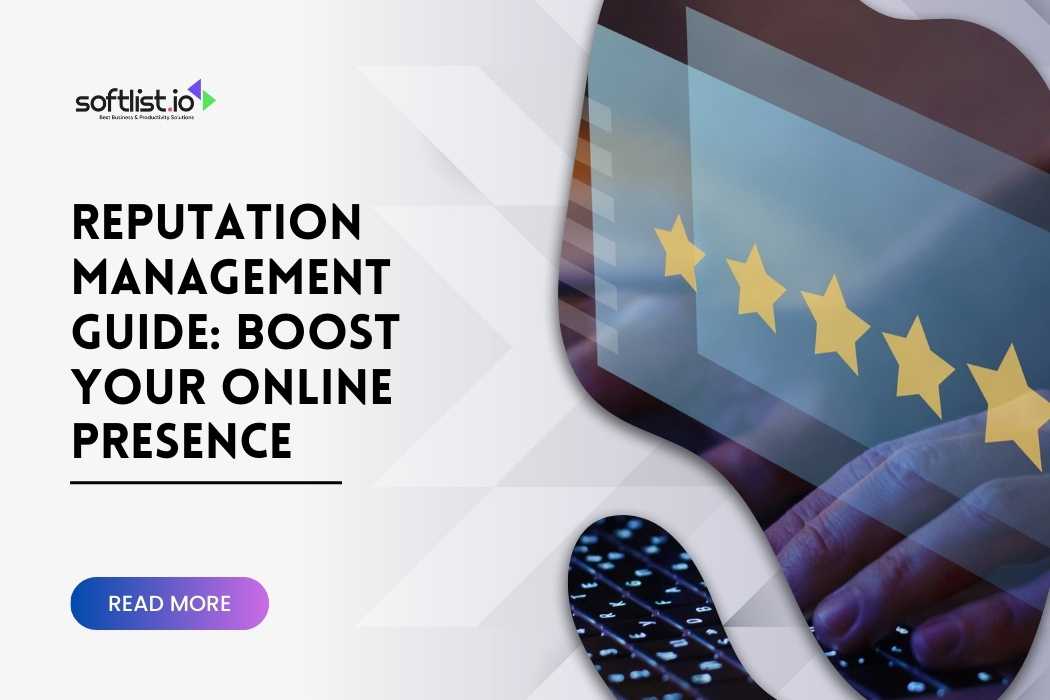Taking care of your image means deciding how people see your brand or business. Your online image can greatly affect how well you do in life. Good reviews and comments can help you get new customers, but bad ones can hurt your reputation.
You should take care of your picture if you want people to believe in you. Keep an eye on your online presence, respond to comments, and spread good word about yourself. These are the main parts of reputation management that this guide will cover. These actions will give your company a strong, positive image that will help it reach its objectives.
Next, we’ll talk about how to keep an eye on your online reputation and reply to comments in a way that makes your brand look better.
Understanding the Components of Reputation Management
Source: Canva Pro
Managing your reputation means watching and changing how people think about your business or personal brand. A few essential parts work together to build a strong brand image over time.
Monitoring Your Online Presence
One of the most critical aspects of reputation management is keeping track of your online reputation. This involves:
- Using reputation management software to monitor mentions of your brand.
- Setting up alerts on platforms like Google Alerts, Mention, and other reputation management tools.
- Regularly check review sites such as Yelp and Trustpilot.
By monitoring your online presence, you can quickly respond to reviews and customer feedback, helping to maintain a positive brand’s online reputation.
Taking Feedback into Account
Effective reputation management involves actively responding to customer reviews and feedback. This includes:
- Thanking customers for positive reviews to show appreciation.
- Addressing negative reviews promptly and professionally to resolve customer issues.
- Using a reputation management dashboard to track and manage responses efficiently.
Responding to feedback is crucial to shaping public perception and improving the customer experience. It shows that you value your customers and are committed to addressing their concerns.
Building a Positive Online Reputation
Source: Canva Pro
Building a positive online reputation requires a proactive approach. It involves creating valuable content, engaging with your audience, and using reputation management strategies to enhance your brand’s reputation.
Creating Valuable Content
Content plays a significant role in reputation management. High-quality content can enhance your online reputation and attract positive attention. Here’s how:
- Publish informative blog posts, videos, and social media updates regularly.
- Ensure your content is relevant, engaging, and provides value to your audience.
- Collaborate with third-party sites to expand your reach and authority.
Creating valuable content helps establish your brand as a leader in your industry and boosts your online reputation.
Engaging with Your Audience
Active engagement with your audience is essential for maintaining a strong brand reputation. Consider the following strategies:
- Respond to comments and messages on social media promptly.
- Participate in conversations around your brand on forums and review sites.
- Use online reputation management software to streamline engagement efforts.
Engaging with your audience shows that you are approachable and value their input, which can lead to more positive reviews and a stronger reputation.
Implementing a Reputation Management Strategy
Source: Canva Pro
A well-planned reputation management strategy is essential for protecting your brand. This includes:
- Developing a comprehensive reputation management plan that aligns with your business goals.
- Using review management software to handle customer feedback and online reviews.
- Employing sentiment analysis to gauge public perception and adjust strategies accordingly.
Measuring Success
To ensure your reputation management efforts are effective, you need to measure success using specific metrics:
- Track changes in customer sentiment using sentiment analysis tools.
- Monitor the volume and nature of online reviews over time.
- Use a reputation management dashboard to visualize data and track progress.
Measuring success helps you identify areas for improvement and make data-driven decisions to enhance your reputation strategy.
More Advice on How to Manage Your Reputation Well
To further strengthen your organization’s reputation, consider these additional tips:
- Regularly update your crisis communication plan to handle any potential crises efficiently.
- Engage in public relations and corporate communication activities to promote your brand.
- Educate your team on best practices for reputation management to ensure consistent efforts across the organization.
Key Figures and Concepts in Reputation Management
Understanding the theories and practices in reputation management can provide deeper insights into developing effective strategies. Key figures include:
- John Doorley, adjunct professor of management in the executive MBA program of New York University’s Stern School of Business, has contributed significantly to the field of corporate reputation management.
- Helio Fred Garcia is a prominent expert in crisis management and communication ethics.
Reputation management is essential for any business aiming to maintain a positive image and achieve long-term success. By monitoring your online presence, responding to feedback, creating valuable content, and engaging with your audience, you can build a strong brand reputation.
Implementing a strategic approach, using the right tools, and continuously measuring your efforts will help protect and enhance your brand’s reputation over time.
Managing Negative Feedback and Crises
Source: Canva Pro
A big part of managing your image is dealing with bad feedback and crises. As a business owner, being able to handle these scenarios well can make all the difference in keeping your good name.
Identifying Potential Crises
Early identification of potential crises is essential for effective crisis management. This involves:
- Monitoring Tools: Use tools to monitor social media, review sites, and news mentions of your brand online. Tools like Google Alerts and specific reputation management software can be invaluable.
- Regular Audits: Conduct regular audits of your online presence to identify any emerging issues that could escalate.
By staying vigilant, you can address issues before they become full-blown crises, protecting your organizational reputation.
Effective Crisis Management
When a crisis does occur, having a well-thought-out strategy is crucial. Here are key steps to manage a crisis effectively:
- Immediate Response: Acknowledge the issue quickly to show that you are aware of it and taking it seriously.
- Internal Coordination: Ensure your team is aligned and informed about the situation. Use a management platform to streamline communication.
- External Communication: Communicate transparently with your audience. Use clear, concise, and honest messaging to manage the perception of the brand.
- Actionable Steps: Outline the steps you are taking to resolve the issue and prevent it from happening again.
Teaching crisis management as part of your organization’s communication strategy and communication ethics ensures that everyone knows their role during a crisis.
Leveraging Social Media for Reputation Management
Social media plays a pivotal role in reputation management. It offers a platform to engage directly with your audience and influence public perceptions of your brand.
Social Media Monitoring
To effectively manage your reputation on social media, monitoring is key. This involves:
- Real-time Tracking: Use reputation management software to track mentions of your brand in real time.
- Sentiment Analysis: Employ sentiment analysis tools to gauge the overall tone of discussions about your brand online.
- Dashboards: Use dashboards to visualize data and identify trends quickly.
These tools to monitor social media can help you stay on top of what is being said about your brand online.
Social Media Engagement
Engaging with your audience on social media is essential for building a strong business reputation. Here are some strategies:
- Respond to Comments: Whether positive or negative, responding to comments shows that you value customer feedback.
- Share Positive Reviews: Highlight positive reviews from your customers to reinforce a positive perception of your brand.
- Proactive Content: Share content that aligns with your brand values and engages your audience. This can include blog posts, videos, and updates about your business functions.
Using social media effectively helps maintain a positive brand online and can significantly enhance your business results.
Implementing a Strategic Management Approach
To effectively manage your reputation, implementing a strategic management approach is essential. This involves creating a strategy that aligns with your business’s needs and goals.
Developing a Reputation Management Strategy
A well-crafted reputation management strategy should focus on several key areas:
- Objective Setting: Define what you want to achieve with your reputation management efforts.
- Stakeholder Identification: Identify key stakeholders and understand their expectations and perceptions of the brand.
- Action Plan: Develop an actionable plan that outlines specific steps and responsibilities.
- Communication Strategy: Incorporate communication ethics and crisis communication into your strategy to handle any issues effectively.
Measuring Success
To ensure your efforts are yielding results, measure the success of your reputation management strategy:
- Metrics: Track metrics such as customer sentiment, volume of positive reviews, and overall brand perception.
- Management Software: Utilize reputation management software to analyze data and adjust strategies as needed.
Key Figures in Reputation Management
Understanding the foundational theories and practices of reputation management can enhance your strategy. Notable figures include:
- John Doorley: An adjunct professor of management in the executive MBA program of New York University’s Stern School of Business, Doorley teaches crisis management and emphasizes the power of communication in maintaining a strong reputation.
- Helio Fred Garcia: Known for his work in communication ethics, Garcia’s teachings focus on the premise that reputation is integral to strategic management and overall business success.
Reputation management is the process of monitoring, influencing, and maintaining how your business or brand is perceived. It focuses on creating a positive reputation through proactive strategies, effective crisis management, and engaging with your audience on social media.
With the right tools and methods, you can protect and improve your business reputation, which will lead to long-term success and good business results..
Implementing a Reputation Management Strategy
Implementing an effective reputation management strategy is crucial for maintaining a positive brand image and achieving long-term business success. This section will guide you through the key steps to develop and execute a comprehensive strategy.
Developing a Strategy
A well-rounded reputation management strategy should be built on clear objectives, stakeholder identification, and actionable steps. Here’s how to create a robust strategy:
- Set clear objectives: define what you aim to achieve with your reputation management efforts. This could include improving customer satisfaction, increasing positive reviews, or enhancing public perception.
- Identify Stakeholders: Understand who your key stakeholders are, including customers, employees, partners, and the broader community. Knowing their expectations and concerns is crucial.
- Create an Action Plan: Develop a detailed action plan outlining the specific steps and responsibilities. Include timelines and milestones to track progress.
Reputation management focuses on proactive measures to build and protect your brand’s image.
Using Management Software
Reputation management software can help streamline your efforts and provide valuable insights. Here are some key benefits:
- Centralized Monitoring: Use management software to monitor all online mentions of your brand from a single dashboard.
- Sentiment Analysis: Tools like sentiment analysis can help gauge public perception and identify areas for improvement.
- Automated Alerts: Set up automated alerts to notify you of new reviews or mentions, ensuring timely responses.
Management software can help your team stay organized and efficient, making it easier to manage your online reputation.
Measuring Success
To ensure your strategy is effective, you need to measure success using specific metrics:
- Customer Sentiment: Track changes in customer sentiment over time using sentiment analysis tools.
- Review Volumes: Monitor the number of positive and negative reviews you receive on platforms like Google Review.
- Brand Perception: Conduct surveys or use tools to measure the overall perception of your brand among stakeholders.
Regularly reviewing these metrics helps you understand the impact of your efforts and make necessary adjustments to your strategy.
The Role of SEO in Reputation Management
SEO plays a critical role in reputation management by influencing how your brand appears in search results. Effective use of SEO can help you manage your online reputation and ensure that positive content about your brand is prominently displayed.
SEO Best Practices
Implementing SEO best practices can significantly enhance your online reputation. Here’s how:
- Keyword Optimization: Ensure your content is optimized for relevant keywords related to your business and industry. This helps improve your search rankings and visibility.
- High-Quality Content: Regularly publish high-quality content that provides value to your audience. This not only improves your SEO but also enhances your brand’s reputation.
- Link Building: Build links from reputable websites to your content. This improves your domain authority and search rankings.
These practices help ensure that positive content about your brand appears at the top of search results, overshadowing any negative content.
Combating Negative Content with SEO
SEO can also be used to push down negative content in search results. Here are some techniques:
- Publish Positive Content: Regularly update your website and social media with positive content. This helps push negative content further down in search results.
- Optimize Existing Content: Optimize your existing positive content to improve its ranking. This includes updating keywords, meta descriptions, and internal links.
- Engage with Positive Mentions: Encourage satisfied customers to leave positive reviews and testimonials. Responding to positive mentions also boosts your online presence.
Using these techniques, you can manage the online narrative about your brand and ensure that negative content does not dominate search results.
SEO is an integral part of reputation management. By following SEO best practices and actively working to combat negative content, you can significantly improve your brand’s online reputation. This, combined with a comprehensive reputation management strategy, helps build a positive public perception and supports long-term business success.
Key Takeaways
- Proactive Monitoring: Use reputation management software to monitor your online presence, including social media, review sites, and news mentions. This allows for timely responses and crisis prevention.
- Engagement is Key: Consumers expect brands to respond within a reasonable timeframe, especially when reaching out on social media. Engaging with your audience shows that you value their feedback and are committed to improving their experience.
- Effective Crisis Management: A well-developed crisis management plan is crucial. This plan includes immediate response, internal coordination, and clear external communication.
- SEO for Reputation Management: Utilize SEO best practices to enhance your online presence. Regularly publish and optimize high-quality content to push down negative search results.
- Strategic Approach: Implement a comprehensive reputation management strategy that aligns with your business goals. Use management software to help your team stay organized and efficient.
Strengthen your business identity. Explore Softlist’s ‘Digital Marketing‘ category for comprehensive tools that promote and protect your brand’s reputation.
FAQs
Why is reputation management important?
Reputation management is crucial for maintaining a positive public perception and supporting long-term business success. In 2021, with the rise of online businesses, managing your reputation has become more important than ever.
What is a good reputation management strategy?
A good strategy involves proactive monitoring, engaging with your audience, effective crisis management, and leveraging SEO. It should be tailored to your specific business needs and goals.
What are the four components of reputation management?
The four main components are monitoring, responding, promoting, and protecting. Each of these focuses on different aspects of managing your brand’s reputation and corporate image.
What is reputation management in PR?
Reputation management in PR involves maintaining and enhancing a brand’s public image through strategic communication efforts. It is often organized by corporate communication units and involves professionals with a wide range of corporate communication backgrounds.
What is the value of reputation management?
The value lies in building trust with your audience, improving customer satisfaction, and ultimately driving business success. A positive reputation leads to better business results and enhances overall brand value.






